350 Search Results for aided language input
November 19, 2020
by Carole Zangari -
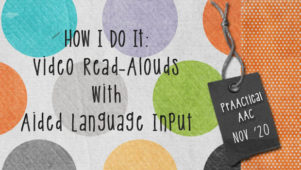
For beginning communicators, the pairing of storybook reading with aided language input is a powerful combination. Today, Dr. Kimberly Ho, SLP and Director of Speech, Language and AAC Services at Confidence Connection, shares her thoughts on selecting which words to model and also shares a number of video examples. Modeling for Children with ASD: Which Words Should We Choose? We know that many individuals with ASD have complex communication needs. It is estimated that 50% of individuals on the Autism Spectrum can’t meet their communication needs with speech alone (Light, Roberts, DeMarco, & Greiner, 1998). This is not surprising to clinicians and educators who have seen their caseloads swell with children with ASD who require AAC. Modeling is the most frequently used instructional method by speech-language pathologists (SLPs) who work with children with ASD who use AAC (Clark & Williams, 2020). Clinically, the intent of providing a model is NOT... [Read More...]
June 24, 2020
by Carole Zangari -
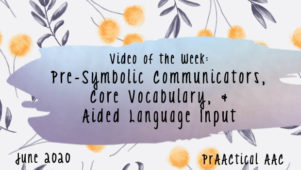
What is the role of core vocabulary and aided language input for communicators who are not yet using symbols to express themselves? SLP Kathryn Dorney, from the Center for Disability and Literacy Studies at the University of North Carolina, provides a perspective in this archived presentation. It is part of the webinar series offered by USSAAC with the support of ISAAC. You can view the handout for this session here. Many thanks to Kathryn, USSAAC, & ISAAC for making this presentation available. Direct Link to Video – https://www.youtube.com/watch?time_continue=24&v=hhIEoPpoR-k&feature=emb_logo
August 6, 2018
by Carole Zangari -
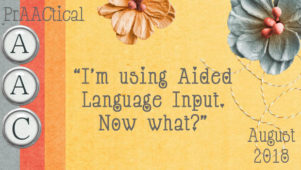
Children who grow up hearing Mandarin generally learn to speak Mandarin. Deaf children who grow up with parents and teachers who use sign language, generally learn to communicate in that sign language. It doesn’t take much imagination to see why children with AAC needs are likely to do best when they are able to see and hear competent communicators use AAC throughout the week. There is a growing body of evidence for the use of aided language input to support AAC learners at the beginning stages of language development and a great many more teachers, therapists, and families are employing these practices. That’s a very good thing. But is aided language input alone sufficient? Research studies have not yet addressed this question, but it is doubtful. Many AAC learners are not able to use observation and incidental opportunities to their advantage. For example, some are challenged with sensory issues that... [Read More...]
May 31, 2018
by Carole Zangari -
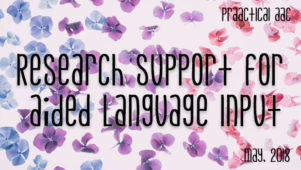
Aided language input, the practice of modeling AAC when speaking to those who are trying to learn AAC, is a pivotal intervention strategy. It has been shown to support comprehension and expression, and the development of early sentence forms. The evidence suggests it may also support the development of certain grammatical morphemes and verb combinations. You can learn more about the implementation of aided language input here. Here are some of the research studies that support the use of this evidence-based practice. Binger, C., & Light, J. (2007). The effect of aided AAC modeling on the expression of multi-symbol messages by preschoolers who use AAC. Augmentative and Alternative Communication, 23, 30–43. Binger, C., Maguire-Marshall, M., & Kent-Walsh, J. (2011). Using aided AAC models, recasts and contrastive targets to teach grammatical morphemes to children who use AAC. Journal of Speech, Language and Hearing Research, 54, 160–176. Dada, S., & Alant, E. (2009). The... [Read More...]
April 11, 2018
by Carole Zangari -

Speak AAC to Teach AAC It’s wonderful to see how many people are actively working on their own skills in aided language input. Today’s video, from the Communication Technology Education Center (CTEC) in northern California, addresses a question that many communication partners have: How much language should I model? Kudos to the STAR team at CTEC for this engaging video. Enjoy! Direct Link to Video – https://www.youtube.com/watch?v=VppaSuAF0f4
March 8, 2018
by Carole Zangari -
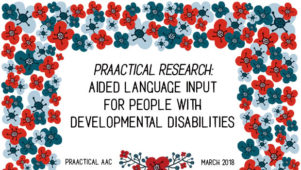
We’re pleased to welcome back Dr. Kathy Howery for another analysis of an AAC research article. Kathy is based in Alberta, Canada, and has worked in the field of AT and special education for over three decades. In the past year, she completed her doctoral studies where she used phenomenological methods to seek to understand the lived experience of speaking with/through a speech generating device. Kathy is currently working as a consultant to schools and school districts across Alberta focusing primarily on children and youth with complex communication needs. ::::::::::::::::::::::::::::::::::::::::::::::::::::::; Allen, A. A., Schlosser, R. W., Brock, K. L., & Shane, H. C. (2017). The effectiveness of aided augmented input techniques for persons with developmental disabilities: A systematic review. Augmentative and Alternative Communication, 33, 149-159. What this Article is All About (The Focus of the Research) This article presents the results of a systematic review of the research into what the authors refer... [Read More...]
June 7, 2017
by Carole Zangari -

Do you know students like these? In therapy sessions, Victor uses single words on his SGD to participate in games and activities, but doesn’t use it much during other daily experiences. Bella uses PECS quite capably at mealtimes but rarely uses it at other times during the day. Karina can use her AAC app to put together short narratives to tell about things that happened recently. Most times, though, she expresses herself with single word utterances. As therapists, teachers, and families who support people who use AAC, we do a lot of hand wringing when there is a discrepancy between what students KNOW HOW to do and what they DO do. We are perplexed and frustrated when these students have everything they need to utilize a particular skill, yet fail to do so. It’s a common concern, but here’s a question for us to ask ourselves: Don’t we do the... [Read More...]
May 31, 2017
by Carole Zangari -
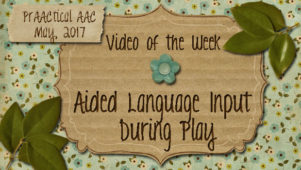
Typically developing children acquire language not through direct instruction but by immersion in an environment where the language of the community is modeled all day long. When they eat and when they play, in care routines at home and in exchanges in the community, children are continually hearing the language they are learning to produce. When parents of Deaf or hard of hearing babies learn of their children’s disability, many clamor to learn sign language and use it as they bathe, feed, and play with their children. These parents may not be perfect sign language models, but they understand that their efforts to learn and use sign language will play a critical role in helping their children learn to communicate effectively. Thus, they strive to sign all day long as they talk to their kids. The pervasive, contextually-driven exposure to language is the foundation on which children build skills in... [Read More...]
April 29, 2016
by Carole Zangari -
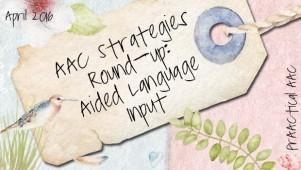
We’ve been writing about aided language input, a pivotal strategy for supporting AAC learners, for several years. In fact, there are over 200 posts tagged with this term. In this post, we gather together some of the most popular posts on this fundamental intervention strategy. Implementation A PrAACtical Idea for Aided Language Input Using Aided Language Input to Build Communication Opportunities! How I Do It: Implementing Aided Language Input with Alicia Garcia Pivotal Skills for AAC Intervention: Aided Language Input How We Do It: Controlled Practice in Partner Augmented Input with Jill Senner & Matthew Baud Text-Based Aided Language: Making the Literacy-Communication Connection for Children with Autism Videos PrAACtical Resources: Video Explainers for Aided Language Input Video of the Week: Aided Language Input with Gail Van Tatenhove Video of the Week: Aided Language Input with Dr. Caroline Musselwhite PrAACtical Resources: Video Examples of Aided Language Input Aided Language Input in... [Read More...]
April 11, 2016
by Carole Zangari -
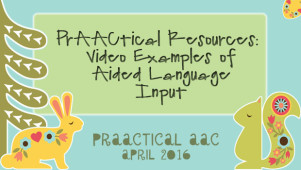
Looking for some examples of aided language input in AACtion? Last month, we shared some video explainers of this powerful strategy. In this post, we have a short list of therapists, educators, and families using this key instructional strategy. Lindy McDaniel with a preschool friend Dynamic Therapy Associates in a speech therapy session Communicare examples for playing a game and reading a book Independent Living Centre of Western Australia on ALI in play Gail Van Tatenhove demonstrating in a classroom group activity Dana Nieder reading at home Shelane Nielson at home making goop









